Project Management: Precautions, Evaluation, Risk Reduction, Gantt Chart, and Comparison with Network Diagram
VerifiedAdded on 2023/06/18
|10
|2399
|470
AI Summary
This article discusses various aspects of project management, including precautions for project leaders, actions to avoid exceeding critical path, measures to evaluate project success, RPN for risk reduction, Gantt chart creation, and useful pieces of information revealed by Gantt chart. It also provides subject-specific references for further reading.
Contribute Materials
Your contribution can guide someone’s learning journey. Share your
documents today.
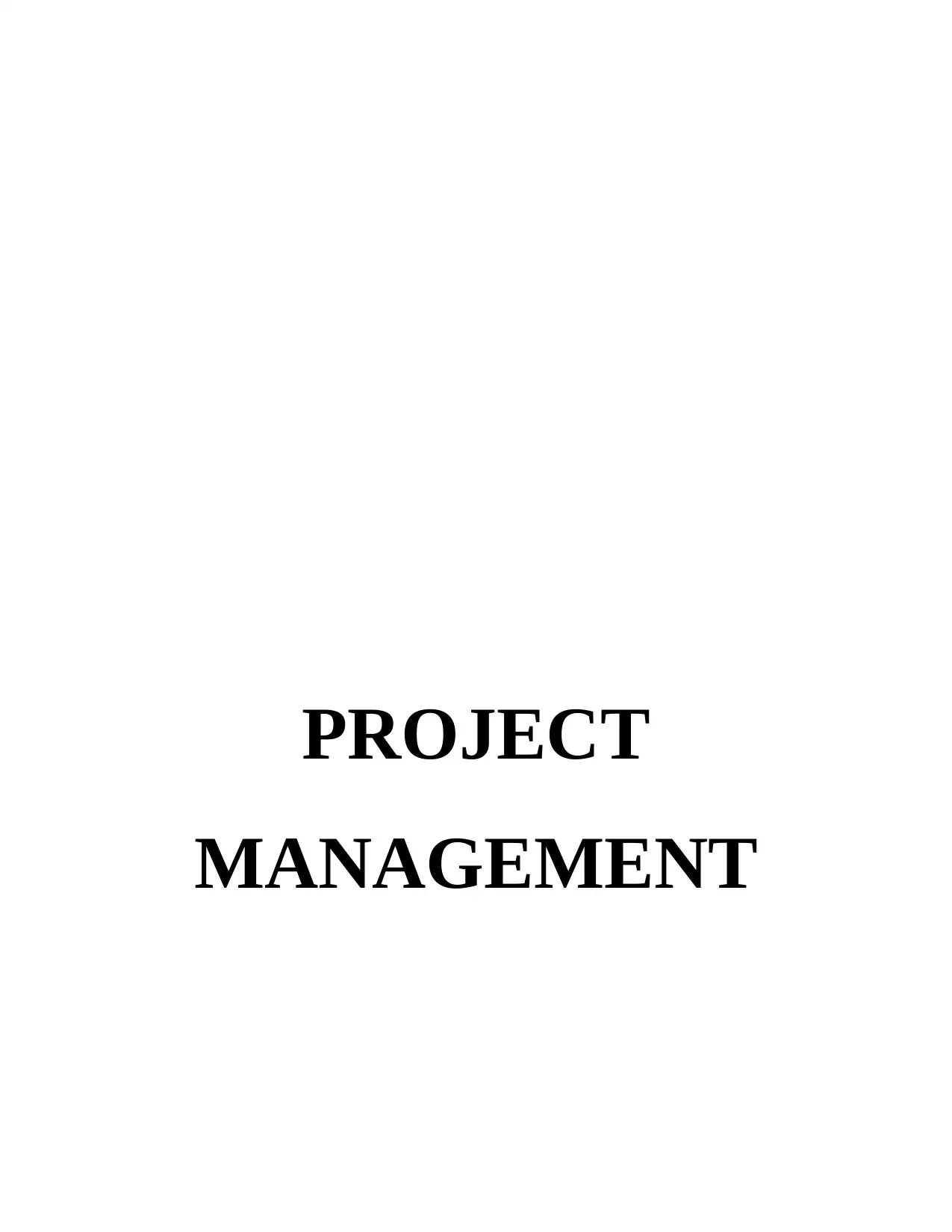
PROJECT
MANAGEMENT
MANAGEMENT
Secure Best Marks with AI Grader
Need help grading? Try our AI Grader for instant feedback on your assignments.

Contents
INTRODUCTION.......................................................................................................................................3
MAIN BODY..............................................................................................................................................3
Understanding 4 generic precautions that a Project leader may take to ensure that there is no delay on
any of a project’s activities......................................................................................................................3
Evaluate two different possible actions that the Project Manager could take to avoid exceeding the
current length of the critical path.............................................................................................................4
Discuss the three measures by which a project is evaluated and at least 2 factors that impact/weigh in
on project success....................................................................................................................................5
Assigning an RPN to potential risks that may occur during a project helps towards reducing the impact
of such risks on the project......................................................................................................................6
Using the Network Diagram information provided, create a Gantt Chart against which project progress
may be monitored....................................................................................................................................7
Identify and discuss two useful pieces of information that a Gantt chart may be used to reveal which a
Network Diagram does not......................................................................................................................8
CONCLUSION...........................................................................................................................................9
REFERENCES............................................................................................................................................9
INTRODUCTION.......................................................................................................................................3
MAIN BODY..............................................................................................................................................3
Understanding 4 generic precautions that a Project leader may take to ensure that there is no delay on
any of a project’s activities......................................................................................................................3
Evaluate two different possible actions that the Project Manager could take to avoid exceeding the
current length of the critical path.............................................................................................................4
Discuss the three measures by which a project is evaluated and at least 2 factors that impact/weigh in
on project success....................................................................................................................................5
Assigning an RPN to potential risks that may occur during a project helps towards reducing the impact
of such risks on the project......................................................................................................................6
Using the Network Diagram information provided, create a Gantt Chart against which project progress
may be monitored....................................................................................................................................7
Identify and discuss two useful pieces of information that a Gantt chart may be used to reveal which a
Network Diagram does not......................................................................................................................8
CONCLUSION...........................................................................................................................................9
REFERENCES............................................................................................................................................9
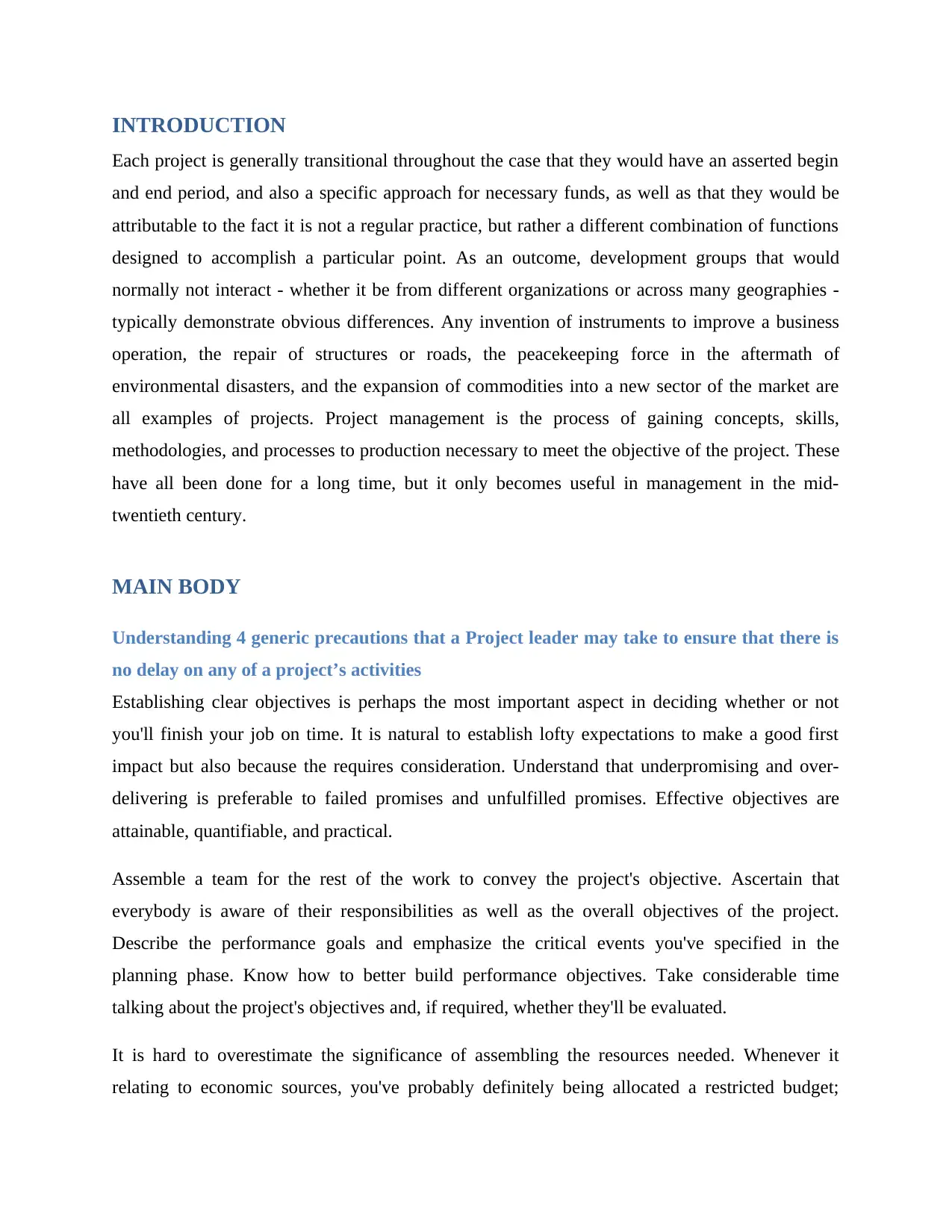
INTRODUCTION
Each project is generally transitional throughout the case that they would have an asserted begin
and end period, and also a specific approach for necessary funds, as well as that they would be
attributable to the fact it is not a regular practice, but rather a different combination of functions
designed to accomplish a particular point. As an outcome, development groups that would
normally not interact - whether it be from different organizations or across many geographies -
typically demonstrate obvious differences. Any invention of instruments to improve a business
operation, the repair of structures or roads, the peacekeeping force in the aftermath of
environmental disasters, and the expansion of commodities into a new sector of the market are
all examples of projects. Project management is the process of gaining concepts, skills,
methodologies, and processes to production necessary to meet the objective of the project. These
have all been done for a long time, but it only becomes useful in management in the mid-
twentieth century.
MAIN BODY
Understanding 4 generic precautions that a Project leader may take to ensure that there is
no delay on any of a project’s activities
Establishing clear objectives is perhaps the most important aspect in deciding whether or not
you'll finish your job on time. It is natural to establish lofty expectations to make a good first
impact but also because the requires consideration. Understand that underpromising and over-
delivering is preferable to failed promises and unfulfilled promises. Effective objectives are
attainable, quantifiable, and practical.
Assemble a team for the rest of the work to convey the project's objective. Ascertain that
everybody is aware of their responsibilities as well as the overall objectives of the project.
Describe the performance goals and emphasize the critical events you've specified in the
planning phase. Know how to better build performance objectives. Take considerable time
talking about the project's objectives and, if required, whether they'll be evaluated.
It is hard to overestimate the significance of assembling the resources needed. Whenever it
relating to economic sources, you've probably definitely being allocated a restricted budget;
Each project is generally transitional throughout the case that they would have an asserted begin
and end period, and also a specific approach for necessary funds, as well as that they would be
attributable to the fact it is not a regular practice, but rather a different combination of functions
designed to accomplish a particular point. As an outcome, development groups that would
normally not interact - whether it be from different organizations or across many geographies -
typically demonstrate obvious differences. Any invention of instruments to improve a business
operation, the repair of structures or roads, the peacekeeping force in the aftermath of
environmental disasters, and the expansion of commodities into a new sector of the market are
all examples of projects. Project management is the process of gaining concepts, skills,
methodologies, and processes to production necessary to meet the objective of the project. These
have all been done for a long time, but it only becomes useful in management in the mid-
twentieth century.
MAIN BODY
Understanding 4 generic precautions that a Project leader may take to ensure that there is
no delay on any of a project’s activities
Establishing clear objectives is perhaps the most important aspect in deciding whether or not
you'll finish your job on time. It is natural to establish lofty expectations to make a good first
impact but also because the requires consideration. Understand that underpromising and over-
delivering is preferable to failed promises and unfulfilled promises. Effective objectives are
attainable, quantifiable, and practical.
Assemble a team for the rest of the work to convey the project's objective. Ascertain that
everybody is aware of their responsibilities as well as the overall objectives of the project.
Describe the performance goals and emphasize the critical events you've specified in the
planning phase. Know how to better build performance objectives. Take considerable time
talking about the project's objectives and, if required, whether they'll be evaluated.
It is hard to overestimate the significance of assembling the resources needed. Whenever it
relating to economic sources, you've probably definitely being allocated a restricted budget;
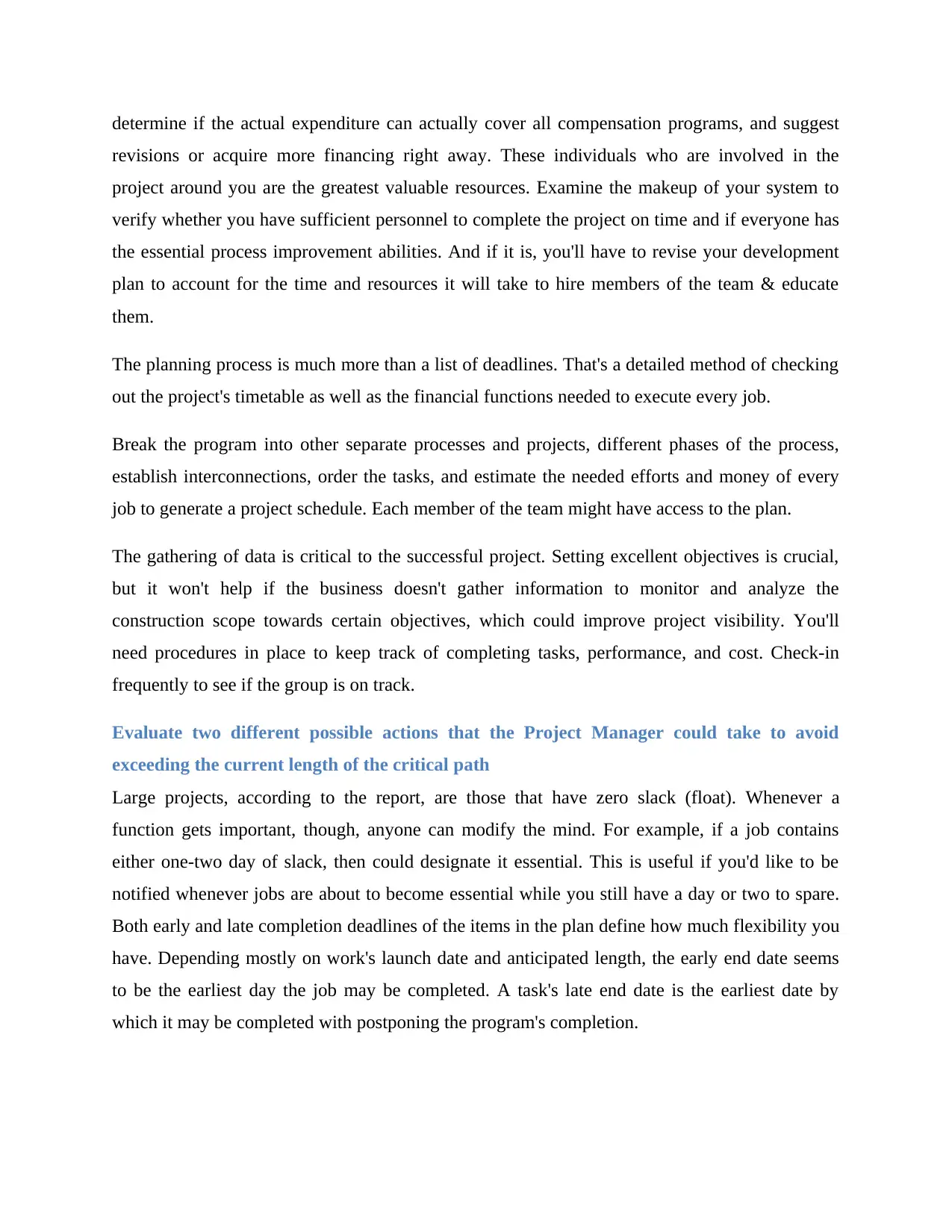
determine if the actual expenditure can actually cover all compensation programs, and suggest
revisions or acquire more financing right away. These individuals who are involved in the
project around you are the greatest valuable resources. Examine the makeup of your system to
verify whether you have sufficient personnel to complete the project on time and if everyone has
the essential process improvement abilities. And if it is, you'll have to revise your development
plan to account for the time and resources it will take to hire members of the team & educate
them.
The planning process is much more than a list of deadlines. That's a detailed method of checking
out the project's timetable as well as the financial functions needed to execute every job.
Break the program into other separate processes and projects, different phases of the process,
establish interconnections, order the tasks, and estimate the needed efforts and money of every
job to generate a project schedule. Each member of the team might have access to the plan.
The gathering of data is critical to the successful project. Setting excellent objectives is crucial,
but it won't help if the business doesn't gather information to monitor and analyze the
construction scope towards certain objectives, which could improve project visibility. You'll
need procedures in place to keep track of completing tasks, performance, and cost. Check-in
frequently to see if the group is on track.
Evaluate two different possible actions that the Project Manager could take to avoid
exceeding the current length of the critical path
Large projects, according to the report, are those that have zero slack (float). Whenever a
function gets important, though, anyone can modify the mind. For example, if a job contains
either one-two day of slack, then could designate it essential. This is useful if you'd like to be
notified whenever jobs are about to become essential while you still have a day or two to spare.
Both early and late completion deadlines of the items in the plan define how much flexibility you
have. Depending mostly on work's launch date and anticipated length, the early end date seems
to be the earliest day the job may be completed. A task's late end date is the earliest date by
which it may be completed with postponing the program's completion.
revisions or acquire more financing right away. These individuals who are involved in the
project around you are the greatest valuable resources. Examine the makeup of your system to
verify whether you have sufficient personnel to complete the project on time and if everyone has
the essential process improvement abilities. And if it is, you'll have to revise your development
plan to account for the time and resources it will take to hire members of the team & educate
them.
The planning process is much more than a list of deadlines. That's a detailed method of checking
out the project's timetable as well as the financial functions needed to execute every job.
Break the program into other separate processes and projects, different phases of the process,
establish interconnections, order the tasks, and estimate the needed efforts and money of every
job to generate a project schedule. Each member of the team might have access to the plan.
The gathering of data is critical to the successful project. Setting excellent objectives is crucial,
but it won't help if the business doesn't gather information to monitor and analyze the
construction scope towards certain objectives, which could improve project visibility. You'll
need procedures in place to keep track of completing tasks, performance, and cost. Check-in
frequently to see if the group is on track.
Evaluate two different possible actions that the Project Manager could take to avoid
exceeding the current length of the critical path
Large projects, according to the report, are those that have zero slack (float). Whenever a
function gets important, though, anyone can modify the mind. For example, if a job contains
either one-two day of slack, then could designate it essential. This is useful if you'd like to be
notified whenever jobs are about to become essential while you still have a day or two to spare.
Both early and late completion deadlines of the items in the plan define how much flexibility you
have. Depending mostly on work's launch date and anticipated length, the early end date seems
to be the earliest day the job may be completed. A task's late end date is the earliest date by
which it may be completed with postponing the program's completion.
Secure Best Marks with AI Grader
Need help grading? Try our AI Grader for instant feedback on your assignments.
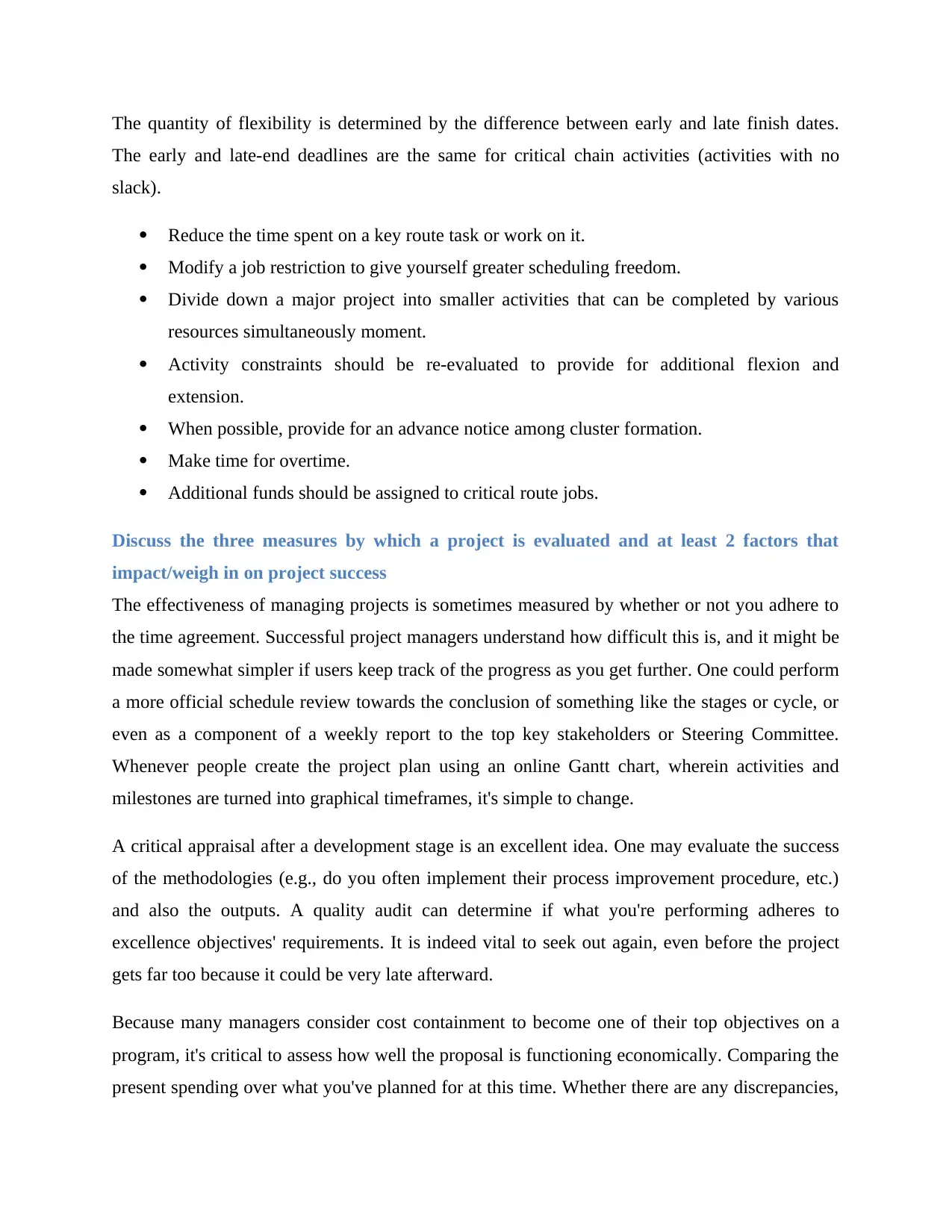
The quantity of flexibility is determined by the difference between early and late finish dates.
The early and late-end deadlines are the same for critical chain activities (activities with no
slack).
Reduce the time spent on a key route task or work on it.
Modify a job restriction to give yourself greater scheduling freedom.
Divide down a major project into smaller activities that can be completed by various
resources simultaneously moment.
Activity constraints should be re-evaluated to provide for additional flexion and
extension.
When possible, provide for an advance notice among cluster formation.
Make time for overtime.
Additional funds should be assigned to critical route jobs.
Discuss the three measures by which a project is evaluated and at least 2 factors that
impact/weigh in on project success
The effectiveness of managing projects is sometimes measured by whether or not you adhere to
the time agreement. Successful project managers understand how difficult this is, and it might be
made somewhat simpler if users keep track of the progress as you get further. One could perform
a more official schedule review towards the conclusion of something like the stages or cycle, or
even as a component of a weekly report to the top key stakeholders or Steering Committee.
Whenever people create the project plan using an online Gantt chart, wherein activities and
milestones are turned into graphical timeframes, it's simple to change.
A critical appraisal after a development stage is an excellent idea. One may evaluate the success
of the methodologies (e.g., do you often implement their process improvement procedure, etc.)
and also the outputs. A quality audit can determine if what you're performing adheres to
excellence objectives' requirements. It is indeed vital to seek out again, even before the project
gets far too because it could be very late afterward.
Because many managers consider cost containment to become one of their top objectives on a
program, it's critical to assess how well the proposal is functioning economically. Comparing the
present spending over what you've planned for at this time. Whether there are any discrepancies,
The early and late-end deadlines are the same for critical chain activities (activities with no
slack).
Reduce the time spent on a key route task or work on it.
Modify a job restriction to give yourself greater scheduling freedom.
Divide down a major project into smaller activities that can be completed by various
resources simultaneously moment.
Activity constraints should be re-evaluated to provide for additional flexion and
extension.
When possible, provide for an advance notice among cluster formation.
Make time for overtime.
Additional funds should be assigned to critical route jobs.
Discuss the three measures by which a project is evaluated and at least 2 factors that
impact/weigh in on project success
The effectiveness of managing projects is sometimes measured by whether or not you adhere to
the time agreement. Successful project managers understand how difficult this is, and it might be
made somewhat simpler if users keep track of the progress as you get further. One could perform
a more official schedule review towards the conclusion of something like the stages or cycle, or
even as a component of a weekly report to the top key stakeholders or Steering Committee.
Whenever people create the project plan using an online Gantt chart, wherein activities and
milestones are turned into graphical timeframes, it's simple to change.
A critical appraisal after a development stage is an excellent idea. One may evaluate the success
of the methodologies (e.g., do you often implement their process improvement procedure, etc.)
and also the outputs. A quality audit can determine if what you're performing adheres to
excellence objectives' requirements. It is indeed vital to seek out again, even before the project
gets far too because it could be very late afterward.
Because many managers consider cost containment to become one of their top objectives on a
program, it's critical to assess how well the proposal is functioning economically. Comparing the
present spending over what you've planned for at this time. Whether there are any discrepancies,
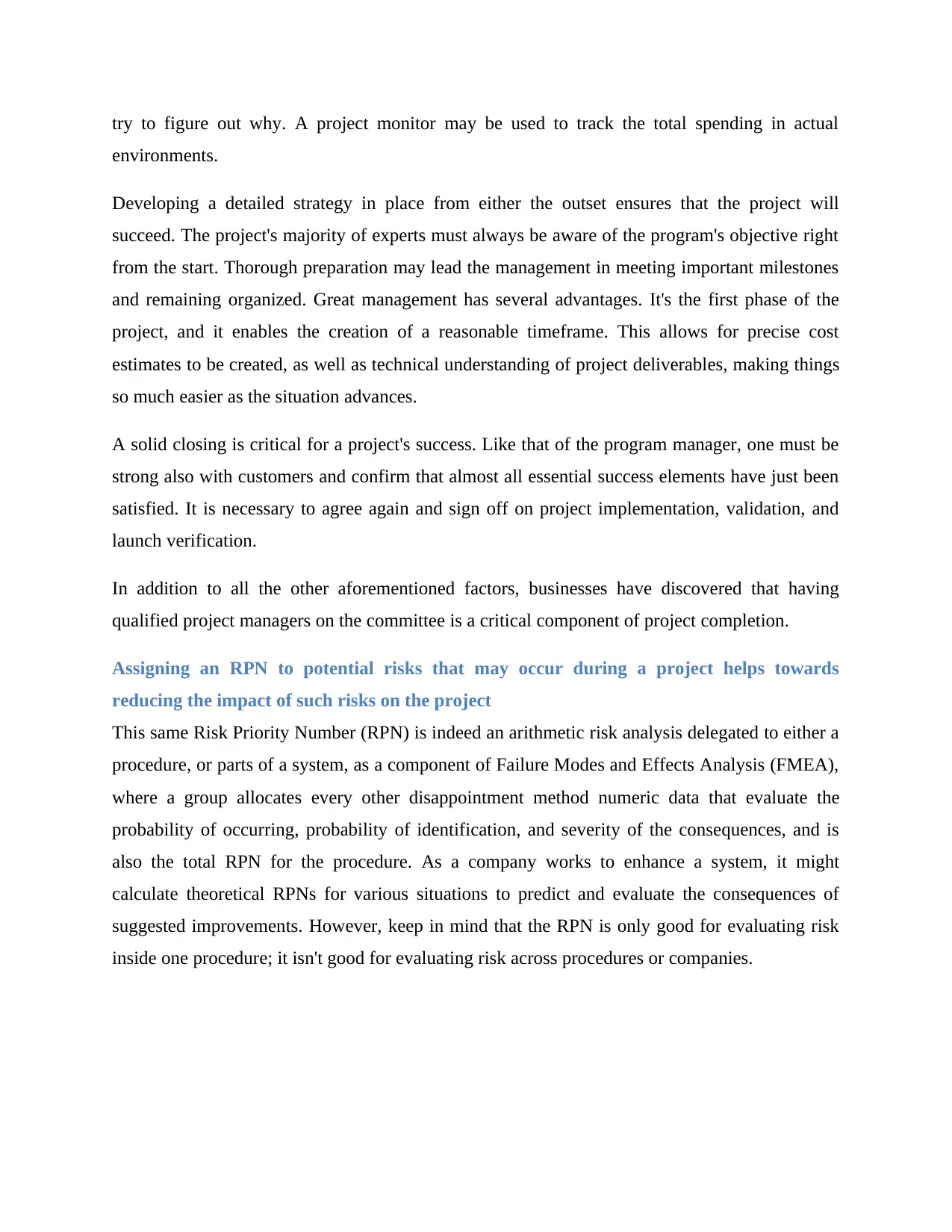
try to figure out why. A project monitor may be used to track the total spending in actual
environments.
Developing a detailed strategy in place from either the outset ensures that the project will
succeed. The project's majority of experts must always be aware of the program's objective right
from the start. Thorough preparation may lead the management in meeting important milestones
and remaining organized. Great management has several advantages. It's the first phase of the
project, and it enables the creation of a reasonable timeframe. This allows for precise cost
estimates to be created, as well as technical understanding of project deliverables, making things
so much easier as the situation advances.
A solid closing is critical for a project's success. Like that of the program manager, one must be
strong also with customers and confirm that almost all essential success elements have just been
satisfied. It is necessary to agree again and sign off on project implementation, validation, and
launch verification.
In addition to all the other aforementioned factors, businesses have discovered that having
qualified project managers on the committee is a critical component of project completion.
Assigning an RPN to potential risks that may occur during a project helps towards
reducing the impact of such risks on the project
This same Risk Priority Number (RPN) is indeed an arithmetic risk analysis delegated to either a
procedure, or parts of a system, as a component of Failure Modes and Effects Analysis (FMEA),
where a group allocates every other disappointment method numeric data that evaluate the
probability of occurring, probability of identification, and severity of the consequences, and is
also the total RPN for the procedure. As a company works to enhance a system, it might
calculate theoretical RPNs for various situations to predict and evaluate the consequences of
suggested improvements. However, keep in mind that the RPN is only good for evaluating risk
inside one procedure; it isn't good for evaluating risk across procedures or companies.
environments.
Developing a detailed strategy in place from either the outset ensures that the project will
succeed. The project's majority of experts must always be aware of the program's objective right
from the start. Thorough preparation may lead the management in meeting important milestones
and remaining organized. Great management has several advantages. It's the first phase of the
project, and it enables the creation of a reasonable timeframe. This allows for precise cost
estimates to be created, as well as technical understanding of project deliverables, making things
so much easier as the situation advances.
A solid closing is critical for a project's success. Like that of the program manager, one must be
strong also with customers and confirm that almost all essential success elements have just been
satisfied. It is necessary to agree again and sign off on project implementation, validation, and
launch verification.
In addition to all the other aforementioned factors, businesses have discovered that having
qualified project managers on the committee is a critical component of project completion.
Assigning an RPN to potential risks that may occur during a project helps towards
reducing the impact of such risks on the project
This same Risk Priority Number (RPN) is indeed an arithmetic risk analysis delegated to either a
procedure, or parts of a system, as a component of Failure Modes and Effects Analysis (FMEA),
where a group allocates every other disappointment method numeric data that evaluate the
probability of occurring, probability of identification, and severity of the consequences, and is
also the total RPN for the procedure. As a company works to enhance a system, it might
calculate theoretical RPNs for various situations to predict and evaluate the consequences of
suggested improvements. However, keep in mind that the RPN is only good for evaluating risk
inside one procedure; it isn't good for evaluating risk across procedures or companies.
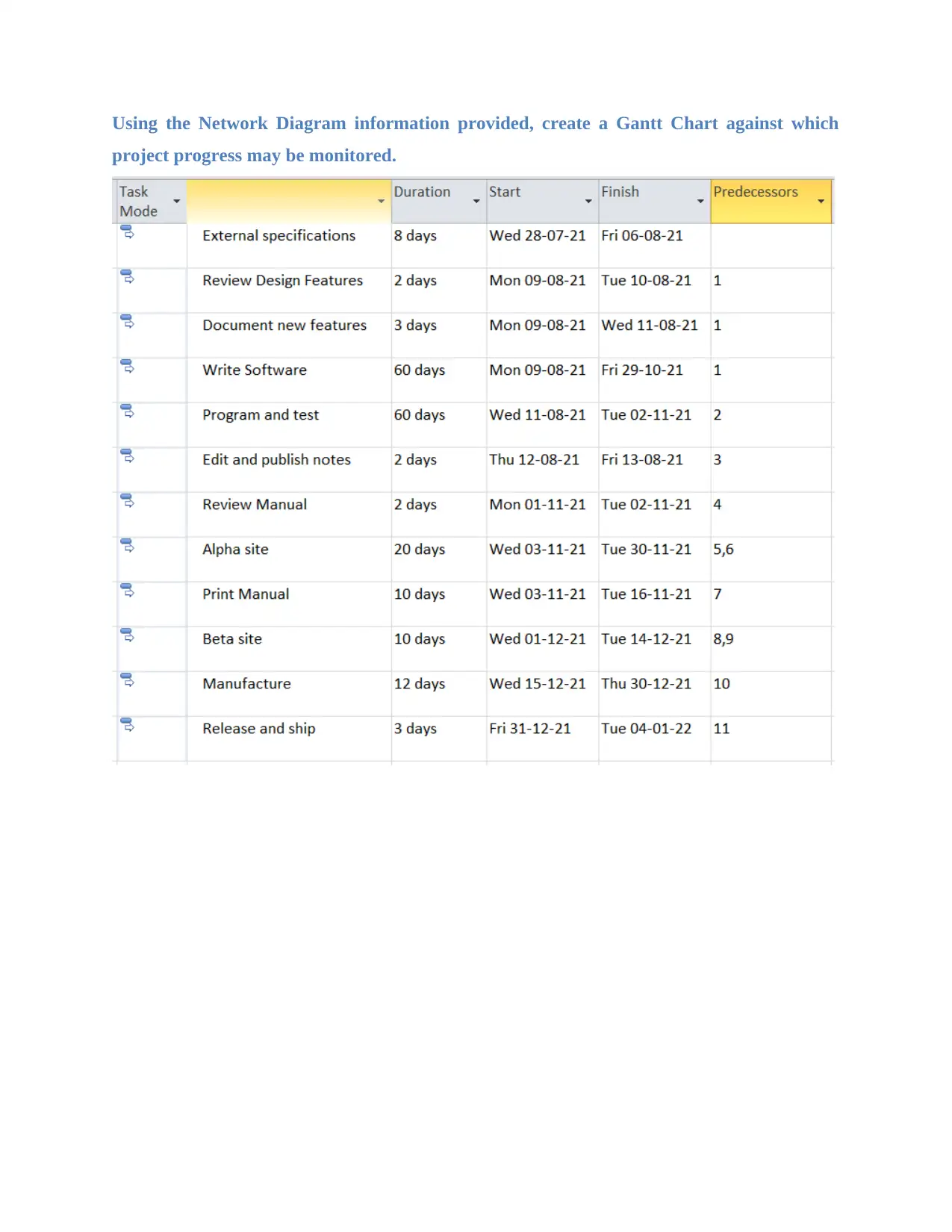
Using the Network Diagram information provided, create a Gantt Chart against which
project progress may be monitored.
project progress may be monitored.
Paraphrase This Document
Need a fresh take? Get an instant paraphrase of this document with our AI Paraphraser

Identify and discuss two useful pieces of information that a Gantt chart may be used to
reveal which a Network Diagram does not
The graph depicts the connection among project activities. Certain jobs must be done before
moving along to the next, and others would be undertaken until the tasks preceding them have
been finished. Determine whether tasks in your business are concurrent but which are
chronological. Observe the relationships among activities when they are interdependent. This
should allow you to understand how to structure your project successfully and that will aid them
in performing tasks on the calendar.
reveal which a Network Diagram does not
The graph depicts the connection among project activities. Certain jobs must be done before
moving along to the next, and others would be undertaken until the tasks preceding them have
been finished. Determine whether tasks in your business are concurrent but which are
chronological. Observe the relationships among activities when they are interdependent. This
should allow you to understand how to structure your project successfully and that will aid them
in performing tasks on the calendar.
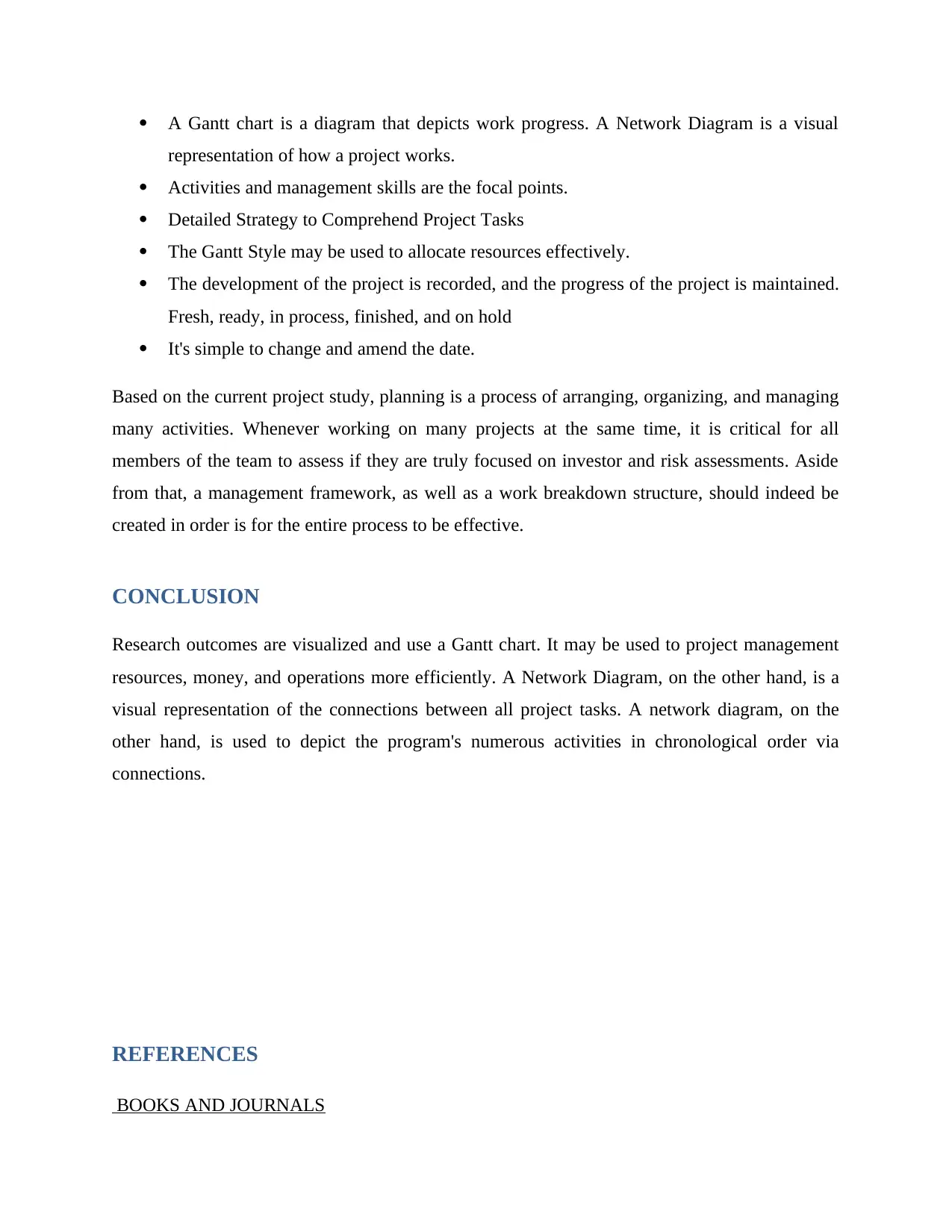
A Gantt chart is a diagram that depicts work progress. A Network Diagram is a visual
representation of how a project works.
Activities and management skills are the focal points.
Detailed Strategy to Comprehend Project Tasks
The Gantt Style may be used to allocate resources effectively.
The development of the project is recorded, and the progress of the project is maintained.
Fresh, ready, in process, finished, and on hold
It's simple to change and amend the date.
Based on the current project study, planning is a process of arranging, organizing, and managing
many activities. Whenever working on many projects at the same time, it is critical for all
members of the team to assess if they are truly focused on investor and risk assessments. Aside
from that, a management framework, as well as a work breakdown structure, should indeed be
created in order is for the entire process to be effective.
CONCLUSION
Research outcomes are visualized and use a Gantt chart. It may be used to project management
resources, money, and operations more efficiently. A Network Diagram, on the other hand, is a
visual representation of the connections between all project tasks. A network diagram, on the
other hand, is used to depict the program's numerous activities in chronological order via
connections.
REFERENCES
BOOKS AND JOURNALS
representation of how a project works.
Activities and management skills are the focal points.
Detailed Strategy to Comprehend Project Tasks
The Gantt Style may be used to allocate resources effectively.
The development of the project is recorded, and the progress of the project is maintained.
Fresh, ready, in process, finished, and on hold
It's simple to change and amend the date.
Based on the current project study, planning is a process of arranging, organizing, and managing
many activities. Whenever working on many projects at the same time, it is critical for all
members of the team to assess if they are truly focused on investor and risk assessments. Aside
from that, a management framework, as well as a work breakdown structure, should indeed be
created in order is for the entire process to be effective.
CONCLUSION
Research outcomes are visualized and use a Gantt chart. It may be used to project management
resources, money, and operations more efficiently. A Network Diagram, on the other hand, is a
visual representation of the connections between all project tasks. A network diagram, on the
other hand, is used to depict the program's numerous activities in chronological order via
connections.
REFERENCES
BOOKS AND JOURNALS
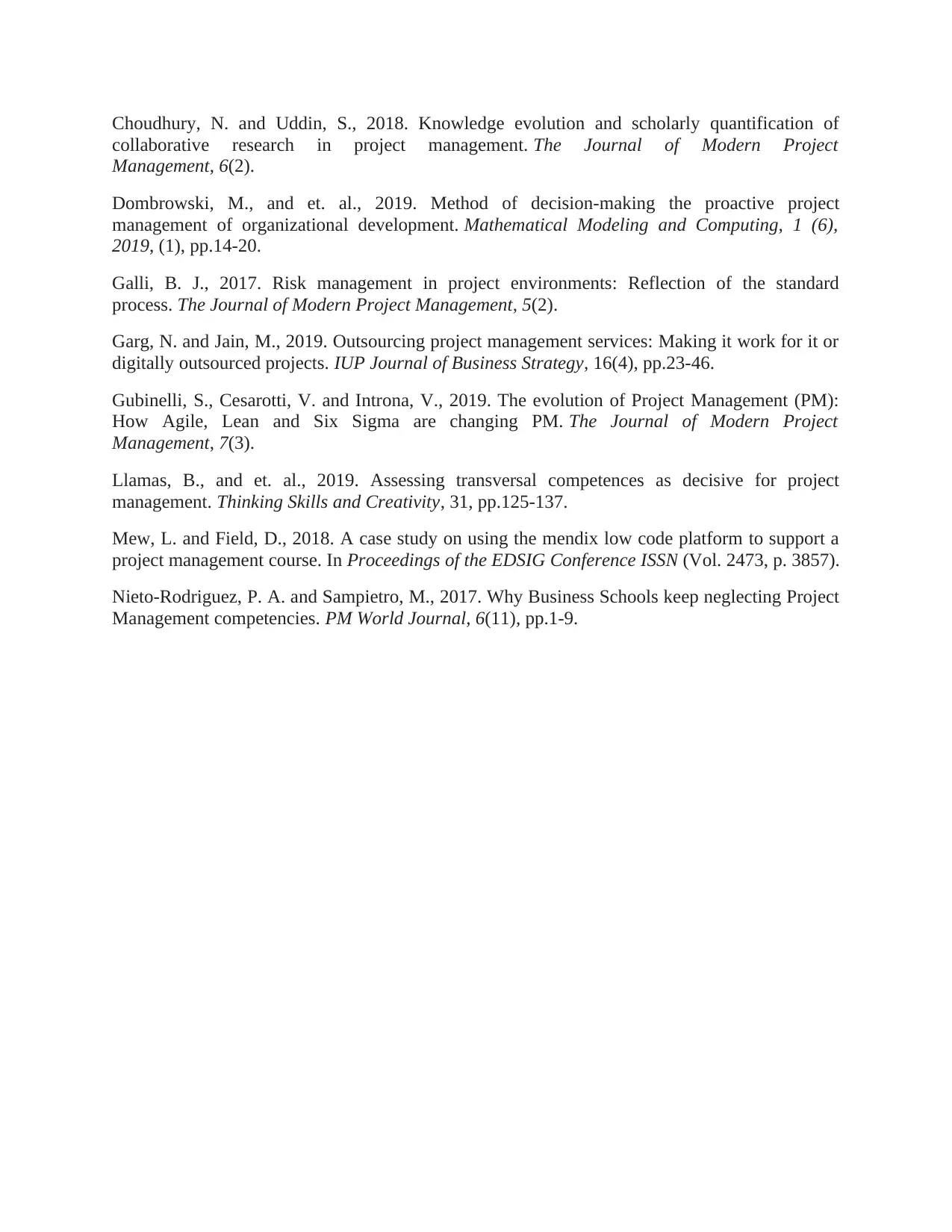
Choudhury, N. and Uddin, S., 2018. Knowledge evolution and scholarly quantification of
collaborative research in project management. The Journal of Modern Project
Management, 6(2).
Dombrowski, M., and et. al., 2019. Method of decision-making the proactive project
management of organizational development. Mathematical Modeling and Computing, 1 (6),
2019, (1), pp.14-20.
Galli, B. J., 2017. Risk management in project environments: Reflection of the standard
process. The Journal of Modern Project Management, 5(2).
Garg, N. and Jain, M., 2019. Outsourcing project management services: Making it work for it or
digitally outsourced projects. IUP Journal of Business Strategy, 16(4), pp.23-46.
Gubinelli, S., Cesarotti, V. and Introna, V., 2019. The evolution of Project Management (PM):
How Agile, Lean and Six Sigma are changing PM. The Journal of Modern Project
Management, 7(3).
Llamas, B., and et. al., 2019. Assessing transversal competences as decisive for project
management. Thinking Skills and Creativity, 31, pp.125-137.
Mew, L. and Field, D., 2018. A case study on using the mendix low code platform to support a
project management course. In Proceedings of the EDSIG Conference ISSN (Vol. 2473, p. 3857).
Nieto-Rodriguez, P. A. and Sampietro, M., 2017. Why Business Schools keep neglecting Project
Management competencies. PM World Journal, 6(11), pp.1-9.
collaborative research in project management. The Journal of Modern Project
Management, 6(2).
Dombrowski, M., and et. al., 2019. Method of decision-making the proactive project
management of organizational development. Mathematical Modeling and Computing, 1 (6),
2019, (1), pp.14-20.
Galli, B. J., 2017. Risk management in project environments: Reflection of the standard
process. The Journal of Modern Project Management, 5(2).
Garg, N. and Jain, M., 2019. Outsourcing project management services: Making it work for it or
digitally outsourced projects. IUP Journal of Business Strategy, 16(4), pp.23-46.
Gubinelli, S., Cesarotti, V. and Introna, V., 2019. The evolution of Project Management (PM):
How Agile, Lean and Six Sigma are changing PM. The Journal of Modern Project
Management, 7(3).
Llamas, B., and et. al., 2019. Assessing transversal competences as decisive for project
management. Thinking Skills and Creativity, 31, pp.125-137.
Mew, L. and Field, D., 2018. A case study on using the mendix low code platform to support a
project management course. In Proceedings of the EDSIG Conference ISSN (Vol. 2473, p. 3857).
Nieto-Rodriguez, P. A. and Sampietro, M., 2017. Why Business Schools keep neglecting Project
Management competencies. PM World Journal, 6(11), pp.1-9.
1 out of 10
Related Documents
Your All-in-One AI-Powered Toolkit for Academic Success.
+13062052269
info@desklib.com
Available 24*7 on WhatsApp / Email
![[object Object]](/_next/static/media/star-bottom.7253800d.svg)
Unlock your academic potential
© 2024 | Zucol Services PVT LTD | All rights reserved.





